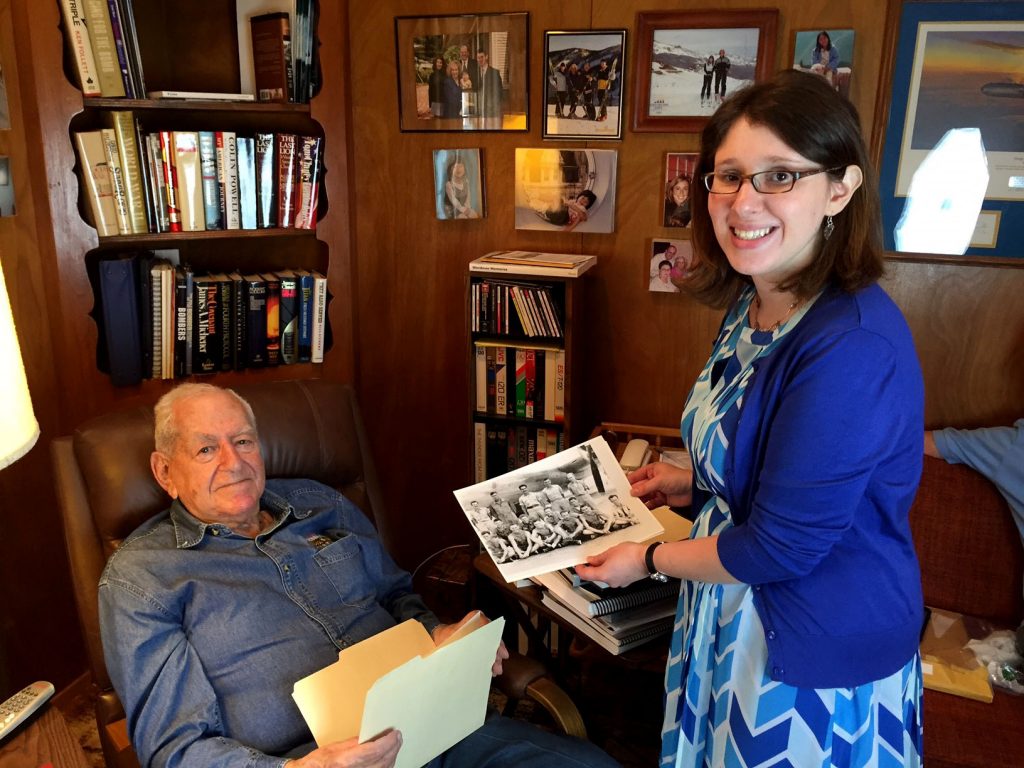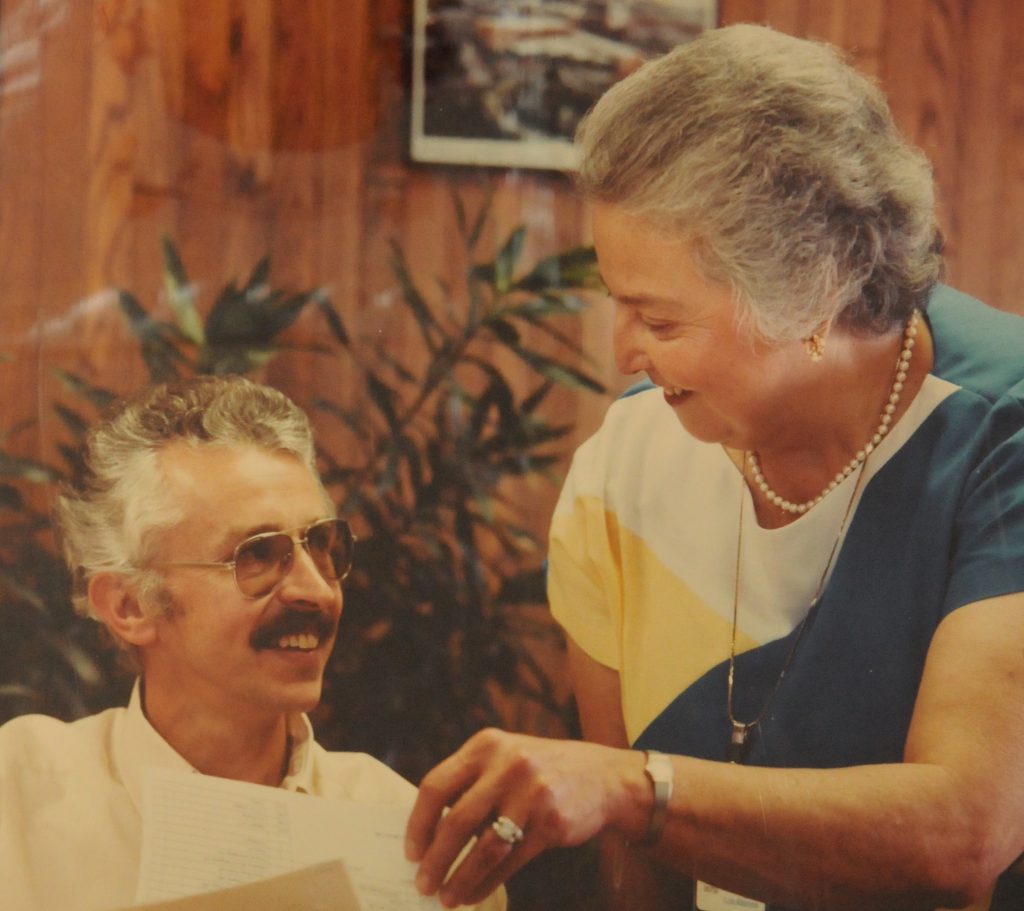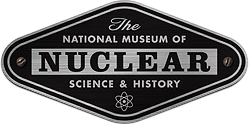The “Voices of the Manhattan Project” oral history website, a joint project of the Atomic Heritage Foundation (AHF) and the Los Alamos Historical Society (LAHS), now features 500 video and audio interviews with Manhattan Project veterans, family members, and experts. As Cynthia C. Kelly, President of AHF, explains, “The website contains 500 first-hand accounts, providing a kaleidoscope of perspectives on the Manhattan Project. Readily accessible online, the collection is a treasure trove for journalists, scholars, documentary producers, museums, educators, students and audiences worldwide.”
“Voices of the Manhattan Project”
Launched in 2012 by AHF and LAHS, the “Voices of the Manhattan Project” website now reaches more than 10,000 people per month. LAHS Executive Director Heather McClenahan states, “What an exciting milestone. This is an amazing resource for researchers and students, as well as our own museum exhibits, which use oral histories as a backbone for understanding daily life and work during the Manhattan Project. These first-hand accounts are a fantastic way for people to connect to this history.”
Both organizations are continuing to record interviews around the country. AHF and LAHS hope to publish an additional 500 interviews on the website by 2020, and to expand the scope of the site to include interviews with Cold War nuclear workers, Japanese atomic bomb survivors, and nuclear experts today.
In addition to interviews conducted by the two organizations, “Voices” features rare archival collections that AHF has received permission to publish. These unique recordings include interviews conducted between the 1960s and the late 2000s by journalists and historians Richard Rhodes, Stephane Groueff, Martin Sherwin, and S. L. Sanger; 509th Composite Group historian Joseph Papalia; and former LANL employees Willie Atencio and David Schiferl. Family members also often donate interviews to AHF for publication.
The Groueff Collection’s recordings are held by the Boston University Howard Gotlieb Archival Research Center, mostly on antiquated 3.5 RPM audio reels. When AHF received the digitized collection of the Groueff Collection, its staff was astonished to discover eleven hours of audio recordings with General Leslie Groves, the director of the Manhattan Project. Groves’ supreme confidence comes through in the interviews. “I emphasized to the scientists that while I didn’t have a PhD, I had been to school a great deal and that I had ten years of formal education after I entered college. I said, ‘That would be the equivalent of about two PhDs, wouldn’t it?’”
To the surprise of many government officials, in 1942 Groves selected J. Robert Oppenheimer to serve as director of the project’s scientific efforts. Oppenheimer described becoming involved in the Manhattan Project in a 1965 interview: “Although I realized that there was a job to do, I did not think it was mine. But that changed in the spring of ’42. I first found out what the project was and saw that it was suffering from a terrible lack of communication, misconceived ideas of secrecy, and inadequate theoretical guidance.” As Groves anticipated, Oppenheimer proved to be an extremely effective scientific director at Los Alamos.
Many of the project’s scientists were refugees from Nazi Europe and were desperately afraid that Germany would develop an atomic bomb before the United States. Leona Woods Marshall, the highest-ranking woman physicist on the project, recalled in a 1986 interview with S. L. Sanger: “I think everyone was terrified that the Germans were ahead of us. They led the civilized world of physics in every aspect at the time that the war set in…Very frightening time.”
The Atomic Bombs
 The “Voices” website includes powerful eyewitness accounts of the Trinity Test and the atomic bombings of Hiroshima and Nagasaki. Val Fitch, a member of the Special Engineer Detachment who would go on to win the Nobel Prize in Physics in 1980, was amazed by the size of the Trinity Test’s explosion. “It’s hard to overstate the impact on the senses of something like that. First the flash of light, that enormous fireball, the mushroom cloud rising thousands of feet in the sky, and then, a long time afterwards, the sound. The rumble, thunder in the mountains. Words haven’t been invented to describe it in any accurate way.”
The “Voices” website includes powerful eyewitness accounts of the Trinity Test and the atomic bombings of Hiroshima and Nagasaki. Val Fitch, a member of the Special Engineer Detachment who would go on to win the Nobel Prize in Physics in 1980, was amazed by the size of the Trinity Test’s explosion. “It’s hard to overstate the impact on the senses of something like that. First the flash of light, that enormous fireball, the mushroom cloud rising thousands of feet in the sky, and then, a long time afterwards, the sound. The rumble, thunder in the mountains. Words haven’t been invented to describe it in any accurate way.”
General Paul Tibbets served as the commander of the 509th Composite Group and piloted the Enola Gay, which dropped the “Little Boy” bomb over Hiroshima. He described the atomic bombing: “The whole sky lit up when it exploded. There was nothing but a black boiling mess hanging over the city. You wouldn’t have known that the city of Hiroshima was there.” Between 170,000 and 246,000 people are estimated to have died from the atomic bombings in the two cities by the end of 1945.
Manhattan Project veterans provide thoughtful reflections on the atomic bombings. Some were shaken by the extent of destruction caused by the atomic bombings. Jean Bacher, who performed calculations at Los Alamos and was married to physicist Robert Bacher, recalled: “I was just absolutely undone. I went home and I could not go to sleep. I just really shook all night. It was such a shock to me. Such a very deep experience, it never leaves you.” Some veterans went on to work on nuclear nonproliferation efforts after the war’s end to ensure that atomic bombs would never be used again.
Other veterans offer different perspectives. Leona Woods Marshall declared, “I have no regrets. In wartime, it was a desperate time. I think we did right and we couldn’t have done differently. When you’re in a war to the death, I don’t think you stand around and say, ‘Is it right?’”
The Manhattan Project’s Legacy
 Interviewees describe the impacts of the project on their communities, including the Hispano communities and Pueblos of northern New Mexico, the Native Americans displaced at Hanford, WA, and the African-American communities in Hanford and Oak Ridge, TN. Eulalia Quintana Newton, who became the first Hispanic woman without a college degree to become a group leader at the Los Alamos laboratory, explained how her job affected her family: “I’ll never forget that I bought my mother her first electric refrigerator with the money that I made up there. Little by little, we modernized the house, we made things a lot more convenient. Our lives changed entirely.”
Interviewees describe the impacts of the project on their communities, including the Hispano communities and Pueblos of northern New Mexico, the Native Americans displaced at Hanford, WA, and the African-American communities in Hanford and Oak Ridge, TN. Eulalia Quintana Newton, who became the first Hispanic woman without a college degree to become a group leader at the Los Alamos laboratory, explained how her job affected her family: “I’ll never forget that I bought my mother her first electric refrigerator with the money that I made up there. Little by little, we modernized the house, we made things a lot more convenient. Our lives changed entirely.”
When the Manhattan Project requisitioned the Hanford area to build the plutonium production reactors and support facilities, Native Americans and farmers were forced off their land. Russell Jim, a member of the Yakama Nation, explained that before the war, “We lived in harmony with the area, with the river, with all of the environment. All the natural foods and medicines were quite abundant here.” Jim and other interviewees describe the negative health impacts experienced by Native Americans, “Downwinders,” and others living in the vicinity of the nuclear production sites.
Many interviewees discuss the legacy of nuclear weapons today. Clifton Truman Daniel, the grandson of President Harry Truman, discusses the threat of nuclear war in a 2018 interview with AHF: “You could just be standing in a beautiful botanical garden enjoying the day, and it would all disappear. That’s the danger of those things. That’s why, together, whether you think it was a good decision or a bad decision, the whole story has to be told.”
AHF and LAHS are very grateful to its funders who have supported the oral history project since 2011, including Crystal Trust, the U.S. Department of Energy, the Institute for Museum and Library Services, the Kerr Foundation, the Los Alamos National Bank, the M. J. Murdock Charitable Trust, and the National Trust for Historic Preservation.





![Chicago Pile-1 reunion, December 2, 1946. Photo courtesy of the University of Chicago Photographic Archive, [apf3-00232], Special Collections Research Center, University of Chicago Library.](https://ahf.nuclearmuseum.org/wp-content/uploads/2016/11/Met Lab CP-1 Group_0-scaled.jpg)